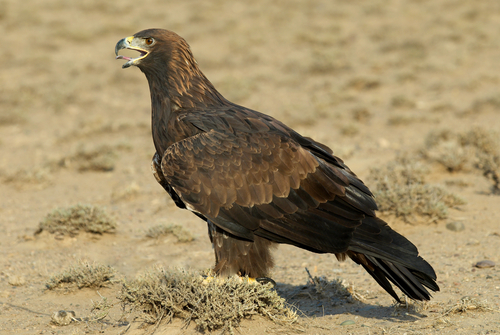
Written by: Sahil
The Golden Eagle(Aquila chrysaetos) is a large bird of prey of the northern hemisphere. It belongs to the hawk and eagle family. it is found in north America, Europe and there are small populations in Africa and Asia minor. It is one of the most widespread species of eagle. With broad, rounded wings, the colors of the Golden Eagle’s feathers range from black brown to dark brown. But it’s the striking golden head and neck that give the bird its common name “Golden Eagle”. The Golden Eagle is a majestic large bird of prey that uses its sharp talons to snatch prey from the ground, which consists of small mammals like rabbits, marmots, young deer, and antelopes.
Description
The Golden Eagle is a large raptor that ranges in length from 66 to 102 cm (26 to 40 in), and its wingspan is 1.8 to 2.34 meters (5 to 7 ft 8 in). Golden Eagle’s wingspan is the 5th largest among the living eagle species. Female Golden Eagles are considerably larger than their male counter parts. Adult Golden Eagles are primarily dark brown with some grey on the inner wing and tail, and a paler, typically golden colour on the back of the crown and nape that gives the species its common name. both male and female Golden Eagles are the same in colour. Juvenile Golden Eagles are similar to adults but tends to be darker on the back.
Habitat
Golden Eagles are usually found on mountains, plateaus and steppes. Sometimes they are also found in scrubland, desert, and tundra habitats. They range from sea level to high mountains such as the Alps and the Himalayas. Golden Eagles can fly hundreds of miles while foraging for their food. They often use mountain ridges to ride the thermal updrafts that sweep up from the valleys and deserts below. These help them gain elevation without expending much flying effort. Some Golden Eagles migrate, but others do not, depending on the conditions of their geographic location.
Behaviour and Diet
Golden Eagles are somewhat solitary birds, but they may bathe in small groups or roost together in cold weather. Immature birds often hang out with each other in winter, and fledgling pairs may preen each other. Golden Eagle pairs maintain large territories as large as 60 square miles. This enables them to find prey and feed their chicks. They are monogamous and mate for life if possible. Usually Golden Eagles nest in high places including cliffs, trees or human structures such as telephone poles.
Golden Eagles use their sharp, large and powerful talons to capture their prey. They mostly prey on rabbits, marmots and ground squirrels. They also eat carrion, reptiles, birds, fish, and smaller fare such as large insects. They have even been known to attack full grown deer.
Reproduction
A golden Eagle pair stays together for life, building several nests in their territory over the years. Each nest is made out of heavy tree branches and grass and built on a cliff face or in a tree. The eagles add more material to the nest each year, so it gets bigger and bigger. The chicks are called eaglets. The oldest chick often attacks and even kills the younger sibling. The eaglets are dependent on their parents for food and the mother feeds the eaglets for about 50 days. Usually at this time. the eaglets attempt their first flight an eat on their own. Eaglets look like the adults but have a duller, more mottled appearance. They have a white-banded tail and white patch on each wing that gradually disappears with every molt. Golden Eagles don’t reach their full adult plumage until they are five years old.
Sahil is a freelance writer who does not necessarily share the opinions expressed on BrantaMedia.com.
